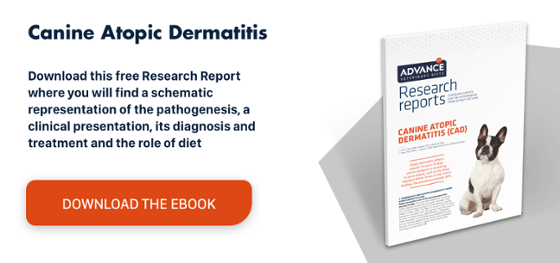Chlorhexidine use in dogs
Chlorhexidine’s mechanism of action is based on rapid binding to bacteria, the absorption of phosphorus compounds from the bacterial surface, overcoming the cell wall protection mechanisms, attraction to the cytoplasmic membrane, loss of low-molecular-weight cytoplasmic components, and cytoplasm precipitation through formation of phosphate complexes.1
Chlorhexidine is active against Staphylococcus intermedius, the most frequent causal agent of canine pyodermas.1 Indeed, chlorhexidine use in dogs is a common treatment for certain dermatological conditions:
- Topical treatment of canine pyoderma caused by Staphylococcus intermedius, as a complement to appropriate systemic therapy.1
- Treatment and control of seborrhoeic dermatitis associated with Malassezia pachydermatis and Staphylococcus pseudintermedius.2,3
- Treatment of the superficial proliferation of Malassezia pachydermatis and control of the associated clinical signs in dogs.4
In these cases, it is often formulated as a shampoo1–4 with concentrations ranging from 0.5–4% (diacetate or digluconate). An appropriate formulation is required, as chlorhexidine may be incompatible with the standard surfactants, especially anionic ones, used in shampoos. It has a prophylactic effect and persists on the skin despite rinsing if applied every 48 hours and for exactly 5 hours under experimental conditions. In addition it is usually well tolerated.5
As a cutaneous antiseptic, a study by Ramos et al. (2019) that treated 15 dogs with different owners and no prior dermatological diseases demonstrated chlorhexidine’s capacity, in association with other compounds, to inhibit the growth of S. pseudointermedius for 10 days in dogs.6
It is contraindicated in animals with hypersensitivity to the active substance.1–4 In very rare cases, dogs may develop a skin reaction with itching or redness after treatment. Again, in very few instances, atopic dogs may develop a pruritic and/or erythematous reaction after treatment.2
Special considerations are to avoid ingestion and contact with the eyes and inner ear; in case of contact, rinse with abundant water and consult a veterinary surgeon.
On another note, it can also be used as an antiseptic and antiplaque solution. Numerous studies have shown that chlorhexidine use in dogs reduces gingivitis if applied consistently over time. Chlorhexidine has rapid onset of action and minimal systemic uptake, making it an excellent option for use as an oral antiseptic.
Conclusions
Chlorhexidine is a broad-spectrum antiseptic with a long history of use in veterinary clinical practice, particularly applications in dermatology and canine dentistry which require familiarity with its different uses. Despite its routine presence around most homes, it should always be prescribed by a veterinary professional.

